The best varieties of edible and decorative honeysuckle for the Moscow region
Growing honeysuckle in the Moscow region does not require special skills and knowledge of planting and care. The plant takes root both in the shade and in sunny areas. The culture is frost-resistant and drought-resistant, rarely affected by rot and drying out, after ripening, the fruits do not crumble for a month. The yield of edible honeysuckle depends on the characteristics of the variety: some take root on nutritious soils, others grow anywhere. What honeysuckle is better to plant in Moscow and the Moscow region, we will consider further.
The content of the article
The best varieties of edible honeysuckle for the Moscow region
Summer residents divide honeysuckle into several categories. Sweet fruit is grown for fresh consumption and processing, large-fruited - for sale and transportation. Self-pollinated varieties are distinguished by stable fruiting, regardless of weather conditions and pollinators. What varieties of large and sweet honeysuckle are chosen by gardeners of the Moscow region?
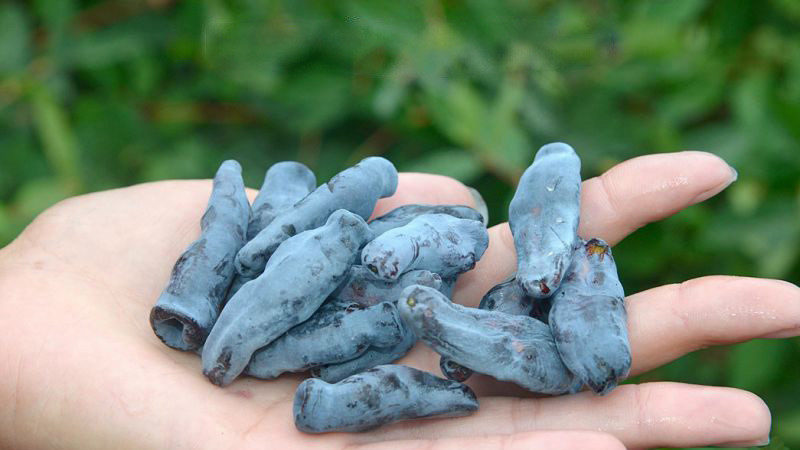
Sweet
The sweet taste of honeysuckle is rare; most varieties have a sweet and sour pulp with a tart aftertaste. Some are bitter due to lack of moisture or variety characteristics.
My joy
Medium late dessert variety of honeysuckle My joy is universal in application. The bushes are medium-sized, with pink dull shoots. The flowers are small, bright yellow in color. The berries are round-oval, blue, with a blue waxy coating. Weight - about 1 g, the stalk is short, the skin is strong, but thin. The pulp is tender and juicy, sweet, not bitter. Fruit tasting score - 4.6 points. About 2-3 kg of berries are harvested from the bush per year. My joy is a frost-resistant variety, rarely damaged by insect pests.
Sweetheart
The name of the tasty variety speaks for itself - the berries are sweet and juicy, the pulp is tender and aromatic, the taste rating is 5 points. Ripening period is average, the plant is compressed, with a rounded crown, shoots are thick and straight. The shape of the berries is oval, the average weight is 0.8 g, the color is deep blue. The skin is thick, with a thick waxy coating, the fruits do not deteriorate during transportation and storage.
Heat resistance and frost resistance are high, therefore Slastena is planted not only in the Moscow region, but throughout Russia. Jam, jams, jellies are prepared from honeysuckle, or they are eaten fresh.
Large
The size of the berries depends not only on the variety, but also on the fertilizer. Fruits will grow large if the culture is timely fed with organic and mineral components - urea, ammonium nitrate, manure, compost, wood ash. Before planting, it is recommended to soak the seedlings in a growth stimulator for 1-2 days.
Bakchar jubilee

The ripening period is medium late, the harvest is harvested in August. The purpose of the variety is universal - Bakchar Jubilee is grown both for sale and for personal use. Bushes are medium-sized, erect shoots, oval leaves. The average berry weight is 1.4 g, the shape is oval, elongated. The color is blue-violet, there is a waxy coating. The pulp is dense and juicy, the taste is sweet and sour, with a refreshing aroma, without bitterness. Honeysuckle is not affected by disease, bears fruit in the third year after planting.
Daughter of a giant
The bushes are vigorous and highly spreading, therefore it is recommended to think in advance about a place for planting. Shoots are straight and strong, gray-brown. The flowers are large, yellow-white.The berries ripen gradually, fruiting is extended. The shape of the honeysuckle is drop-shaped, elongated, weight - from 1.8 to 2.5 g. The color is violet-blue, with a waxy bloom, the skin is strong. The taste is sweet and sour, with a bright aroma, the pulp is firm and elastic.
Interesting! So that the honeysuckle does not crumble after ripening, it is sprayed with a urea solution. So the fruits hang on the bush for another 5-7 days. Gardeners use one trick - they put an unfolded umbrella under the bush so that the berries do not fall to the ground when they fall.
The Giant's Daughter variety is not damaged by spider mites and aphids, frost resistance - up to -35 ° С. Suitable for processing and fresh consumption, drying and freezing.
Self-pollinated
Self-pollinated varieties are distinguished by the presence of bisexual flowers - male and female. Such honeysuckle does not require pollinating insects - wasps and bees. However, some growers prefer to plant several different varieties side by side for cross-pollination and higher yields.
Yugan
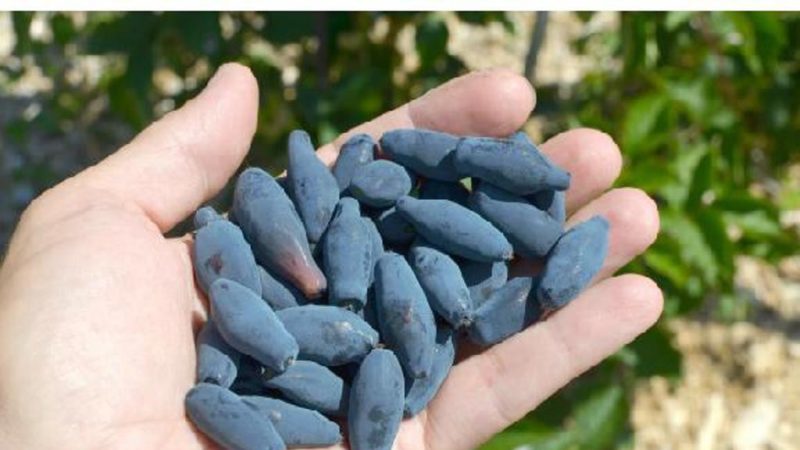
The ripening period is average, the harvest is harvested in mid or late July. Self-fertile variety resistant to crumbling, not affected by rust, gray mold and powdery mildew. The bushes are medium-sized, with a dense crown, the shoots are straight and dull. Leaves are oval, rich green. The berries are pitcher-shaped, weigh about 1.2 g, deep blue color, with a waxy coating. The taste is sweet, with a pleasant sourness, the tasting score is 4.8 points.
Due to its dense skin, Yuganu is grown for sale and processing. Drought resistance is high, honeysuckle tolerates long-term lack of moisture. Bears fruit for 4 years after planting.
Nymph
The variety is medium early, the first fruits are picked in the second decade of June. Bushes vigorous, with thick shoots. The leaves and flowers are large. Berries are fusiform, elongated, average weight - 0.8 g. The surface is bumpy, heterogeneous, the color is blue, with a blue tint. The pulp is pleasant and juicy, the taste is sweet, with sourness, without bitterness. The Nymph's score is 4.7 points. Saplings quickly adapt to climatic conditions, rarely get sick, and are not damaged by aphids.
Read also:
The most productive
The yield of honeysuckle depends on the place and time of planting, the characteristics of the variety, soil condition, weather conditions, compliance with agrotechnical rules. It affects the productivity and immunity of the plant to diseases: the higher it is, the more healthy and ripe fruits.
Long-fruited
The variety is early maturing, winter-hardy, resistant to shedding. The ripening period of the Long-fruited is June 10–20. The bushes are weak and very spreading, the shoots are thin, curved. The berries are lumpy, elongated, the weight of one is about 0.8 g, the length is 2.7 cm. The color is blue, there is a waxy coating, the stalk is long. The taste is harmonious, sweet, with a refreshing aftertaste and aroma. Honeysuckle is suitable for freezing and jam production. Productivity from one bush per season - from 2 to 4.5 kg.
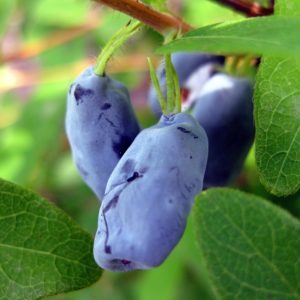
Cinderella
Cinderella's universal honeysuckle begins to bear fruit 3 years after planting. The bushes are weak, the shoots are thin, without pubescence, the crown is dense. Shrubs are compact, take up little space. The berries are elongated-oval, average weight - 1.2 g, black color, with a blue bloom. The pulp is soft, with an original strawberry aroma and sweet taste. The stem is medium in size, the skin is thin. The variety is resistant to spring frosts, average shedding. Productivity - up to 3 kg per plant over the summer.
Interesting! To increase yields, it is recommended to regularly feed honeysuckle. In April, 30 g of urea is applied to a depth of 20-30 cm; in July, plantings are fertilized with slurry at the rate of 10 liters per bush. Superphosphate is introduced in September (15 g per plant).
The best varieties of honeysuckle by fruiting time
The early varieties ripen in early summer, when other garden berries are just gaining flavor and color. Medium honeysuckle ripens at the end of June, fruiting lasts 2-3 weeks; late ripens by the beginning of August.
Early ripe
- Summer residents distinguish from early varieties Pushkinskaya. Dessert berries, sweet and sour, with a delicate aroma. Cylindrical shape, weight - about 1 g, deep blue-blue color. The peel of Pushkinskaya is thin, waxy bloom of medium density. After ripening, the berries do not crumble, retain their shape. Medium-sized bushes are unpretentious in care, suitable for growing in arid regions. They use Pushkinskaya in any form.
- An early frost-resistant variety is popular Strezhevchanka. Bushes are medium spreading, with straight brown shoots. The leaves are small, green and dull. Berry weight - from 1 to 2 g, oval shape. The color is blue, with a slight waxy bloom. Berries are fragrant sweet and sour, tasting score - 4.9 points. Strezhevchanka's crushing rate is average.
Mid-season
- Mid-season honeysuckle variety Owl it has stable fruiting and high yield. During the season, about 2 kg of berries are harvested from the plant. The bushes are medium-sized, the leaves are green. The berries are drop-shaped, weigh about 1 g, color is blue. The skin is of medium thickness, the taste is sweet and sour. The owl is self-fertile, therefore it is recommended to plant pollinating varieties next to it: Blue bird, Chelyabinka, Giant's daughter. Among the advantages are the dessert taste, winter hardiness, immunity to diseases, unpretentiousness.
- Another popular mid-season honeysuckle variety is Chulymskaya. It takes root on any soils, including acidic ones. Self-pollinated fruitful variety. The height of the bush is about 1.3 m, the berries are elongated-conical, slightly flattened. Pointed tip, violet-blue color. The taste is sweet and sour, the weight of the berry is about 1.5 g. The yield of Chulym is from 2 to 4 kg per plant. Honeysuckle does not need pollinators and frequent shoot pruning, which makes it easier to care for the plant. Jams, compotes, syrups and jams are made from berries. Chulymskaya is not sheltered for the winter.
Late
- Late-ripening variety Darling differs in elongated berries with a pointed tip, the weight of one is about 1.2 g. The color of the fruits is black-blue, with a waxy coating, the pulp is tender, the taste is sweet and sour. Long berries - about 2 cm - sit tightly on the shoots, do not crumble. Bushes of medium height, with a round, compressed crown. In early spring, the Chosen One is cut off - near the main stem, side shoots are removed along with the stepsons. The yield of late honeysuckle is from 2 to 3 kg per bush. It is not affected by fungal diseases, frost resistance - up to -30 ° C.
- Along with the Chosen One, summer residents also plant late honeysuckle Selena. The bushes are medium-sized, dense, strongly pubescent shoots, rich green leaves. The berries are elongated, with a sharp tip, the average weight is 1 g. The color is black-blue, with a blue bloom. The taste is sweet and sour, slightly bitter. The harvest is universal in use: the berries are eaten fresh, ground with sugar, used for making compote and jams, and frozen.
Read also:
Frost-resistant early ripe variety of honeysuckle "Lakomka"
Decorative honeysuckle for Moscow region
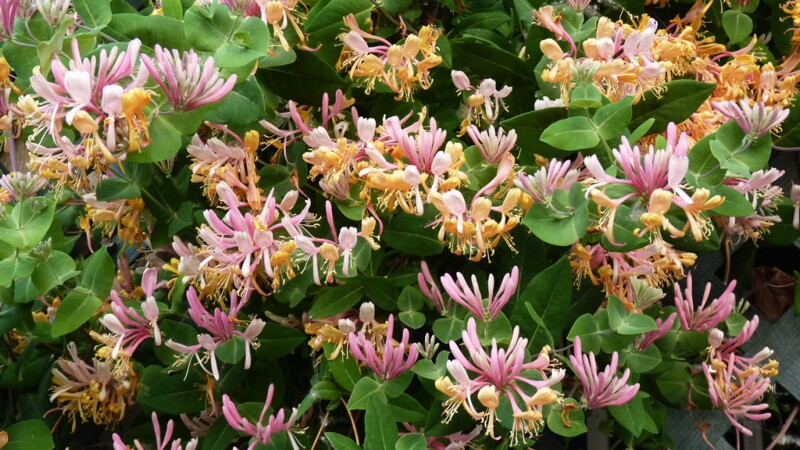
Decorative honeysuckle is elegant and graceful, in beauty it is not inferior to exotic plants. Shrubs are planted along the fence or in the corners of the garden, in personal plots. Often, decorative honeysuckle acts as a hedge, effectively decorating any place. Some of the most popular decorative species are honeysuckle and oriental.
- Honeysuckle reaches a height of 3 m, flowering begins in June. The flowers are creamy pink, placed one above the other. In August, pink-red berries ripen on the bushes, they grow in pairs. The culture is unpretentious in growing, requires a minimum of care and time. The species is frost-resistant, suitable for decorating garden arches and verandas.
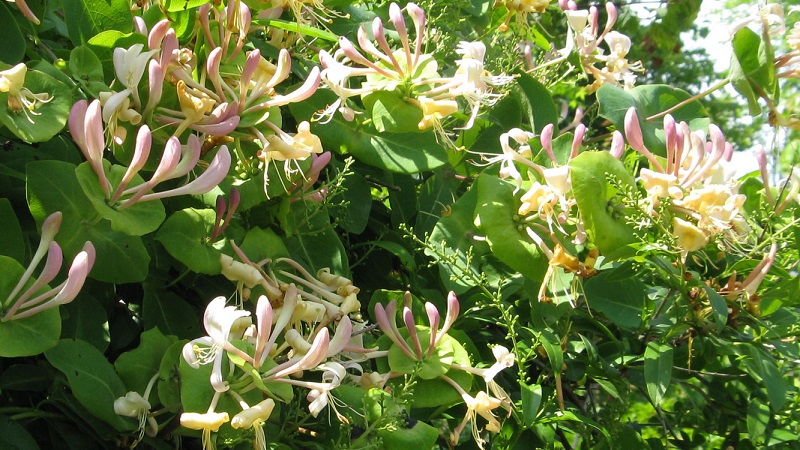
- Eastern honeysuckle, or Caucasian, reaches a height of 1.5–2.5 m, small bushes fit perfectly into compact garden areas. The flowers are pink-purple, growing on long, thin green legs. Flowering begins in May and lasts until June.In August, large blue-black fruits ripen.
Features of planting and care in the Moscow region

For planting in the Moscow region, unpretentious and fruitful varieties are chosen. It is advisable to plant several different bushes side by side, because most varieties are self-fertile and require cross-pollination. The site is cleared of debris and weeds, dug onto the handle of a shovel. A pit 50 cm deep is prepared and manure, compost, humus and nitrophosphate are introduced into it. If the soil is acidic, it is lime.
Attention! It is recommended to plant seedlings with an open root system in summer or late autumn. If the plant is sold in a pot, any warm season is suitable for planting, except for the flowering period. The suitable age for seedlings is 2 or 3 years. Older plants often get sick.
For the first 15 days after planting, the soil around the seedling should be slightly damp. Do not fill the plant with water - the risk of developing fungal diseases is high. Adult plants are watered once every 3-4 weeks, before moistening, they loosen the ground and remove weeds, use the sprinkling method. Large-fruited varieties require additional nutrition. Top dressing strengthens the plant's immunity, stimulates the growth of fruits. Once a month, the bushes are sprayed with a solution of Bordeaux liquid - foliar fertilizers protect against diseases and pests.
Conclusion
What is the best honeysuckle for the Moscow region? Summer residents choose varieties of Slasten, Nymph, Yugan, Daughter of a giant. They are distinguished by frost resistance, immunity, versatility in use. The most productive honeysuckle - Long-fruited and Cinderella - pleases with a stable and high yield. Before planting a crop, it is advisable to study the rating of the best varieties, their description and features. It is easy to care for honeysuckle, the main thing is to observe the irrigation regime and fertilize the soil 3 times per season.